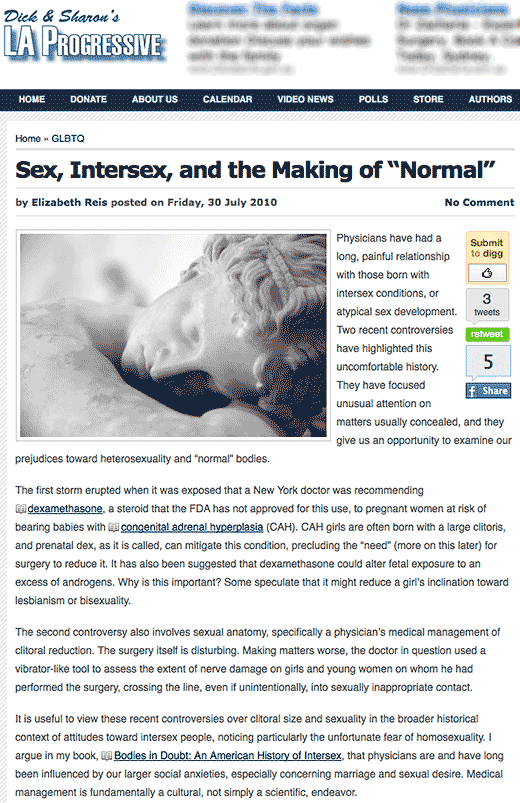Bodies in Doubt
In 2009 Dr Reis’s book, Bodies in Doubt: An American History of Intersex, examined the cultural contexts that both inform and drive western medicine’s attitudes and responses to intersex bodies. Beginning with the profound homophobia of the 19th through to the 21st centuries, to the taboo topic of neo-vaginal dilation, Reis challenged standard medical practices regarding intersex bodies.
Now, following the recent disclosures that the sex steroid dexamethasone (dex) was being prescribed experimentally to some expectant New York women suspected of carrying CAH affected foetuses, and that Dr Dix P. Poppas of Cornell University made a practice of surgically “normalising” the clitorises of intersex children with CAH – Congenital Adrenal Hyperplasia – then stimulating their mutilated sex organs with an instrument not unlike a vibrator, Elizabeth Reis has spoken out again.
OII Australia is grateful to Dr Reis for speaking out the way she has.
Physicians have had a long, painful relationship with those born with intersex conditions, or atypical sex development. Two recent controversies have highlighted this uncomfortable history. They have focused unusual attention on matters usually concealed, and they give us an opportunity to examine our prejudices toward heterosexuality and “normal” bodies.
The first storm erupted when it was exposed that a New York doctor was recommending dexamethasone, a steroid that the FDA has not approved for this use, to pregnant women at risk of bearing babies with congenital adrenal hyperplasia (CAH). CAH girls are often born with a large clitoris, and prenatal dex, as it is called, can mitigate this condition, precluding the “need” (more on this later) for surgery to reduce it. It has also been suggested that dexamethasone could alter fetal exposure to an excess of androgens. Why is this important? Some speculate that it might reduce a girl’s inclination toward lesbianism or bisexuality.

The second controversy also involves sexual anatomy, specifically a physician’s medical management of clitoral reduction. The surgery itself is disturbing. Making matters worse, the doctor in question used a vibrator-like tool to assess the extent of nerve damage on girls and young women on whom he had performed the surgery, crossing the line, even if unintentionally, into sexually inappropriate contact.
It is useful to view these recent controversies over clitoral size and sexuality in the broader historical context of attitudes toward intersex people, noticing particularly the unfortunate fear of homosexuality… physicians are and have long been influenced by our larger social anxieties, especially concerning marriage and sexual desire. Medical management is fundamentally a cultural, not simply a scientific, endeavour. …
… efforts to make the genitals look “normal” and to prevent homosexuality still exist. We continue to be profoundly unsettled by any body that falls outside the parameters of “normal,” particularly in terms of sex anatomy, and, despite our growing openness to same-sex desire, we remain deeply troubled by that potential as well. It is time to be mindful that medical views are embedded in a particular context. Once we become explicit about our biases, perhaps we can work to change them.
More information
One Comment
Comments are closed.
“Physicians have had a long, painful relationship with those born with intersex…”
Let’s put that another way, shall we? Consider this:
Intersex people have long been subjected to painful mistreatment by physicians.
Painful, brutal, disrespectful mistreatment that has been entirely unnecessary, inexcusable and utterly unjustifiable.
Physicians, stop it right now! Get your grubby hands and sick little minds off of intersex genitals immediately. If it weren’t for your white coats, the men in blue would have carted you off to prison long ago. Some intersex people would like to see you carted off to jail despite your white coats.